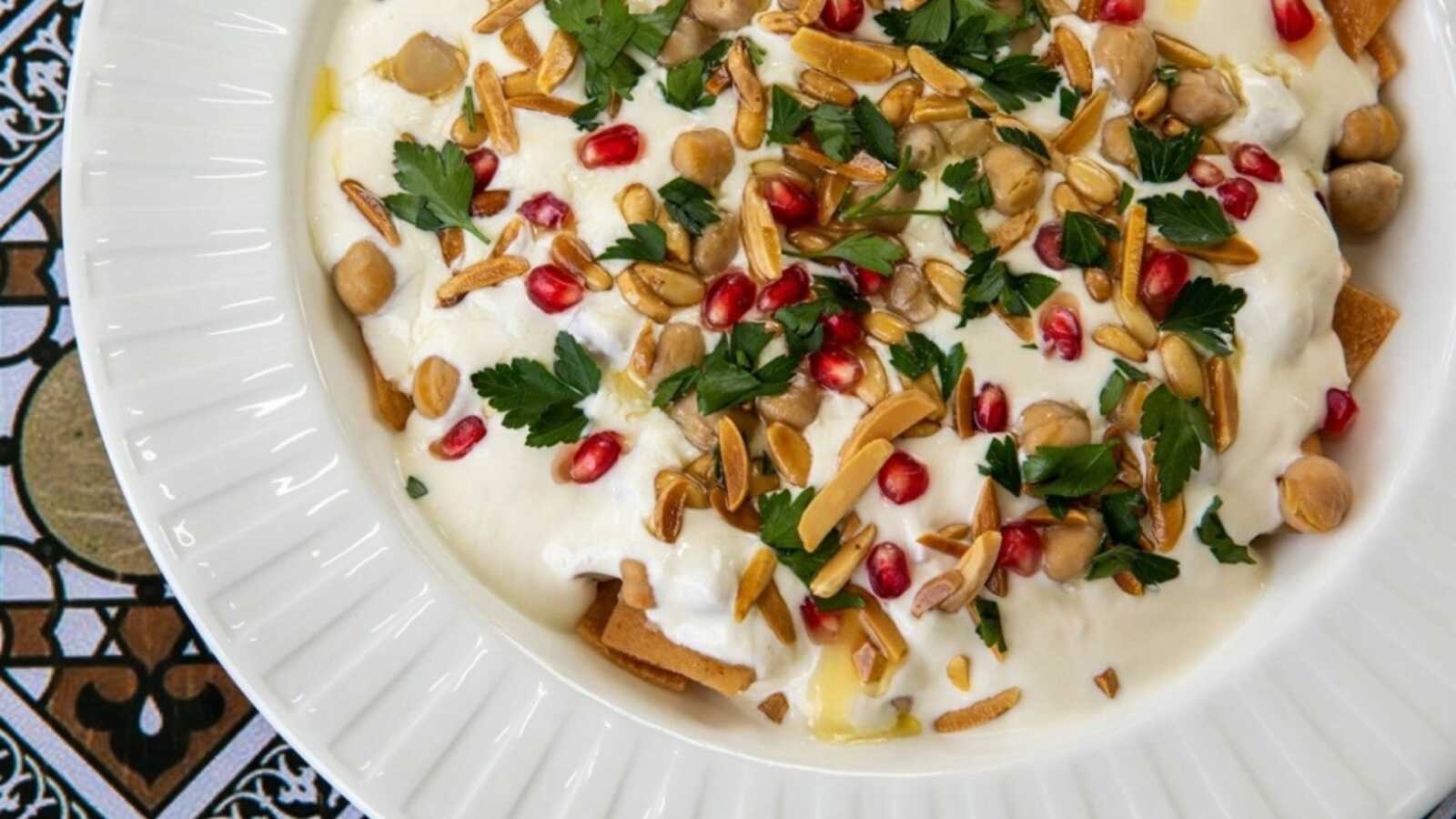[wprm-recipe-jump]
What is fatteh?
Fatteh is a tasty, layered Middle Eastern dish comprised of toasted Arabic bread that is topped with various ingredients depending on the region. Traditionally, Lebanese Fatteh is made to be shared, and topped with chickpeas, yogurt, pine nuts, and a garnish.
Ingredients:
- 28 ounces of canned chickpeas
- 4 tablespoons of ghee or oil for deep frying
- 2 large rounds Arabic pocket bread cut into 2-3 cm squares
- 2 garlic cloves (crushed)
- 2 pounds natural Greek yogurt
- 3 tablespoons of tahini (hulled)
- 4-5 tablespoons of cold water
- salt to season
- 1 tablespoon of ghee (extra)
- ⅓ cup pine nuts
Cookware:
- Individual serving bowls or a glass/ceramic baking dish (approximately 2.8L in size)
- Small pot (to heat up the chickpeas and fry the pine nuts in)
- Medium-sized frying pan (for the crispy bread)
- A medium-sized bowl (for the yogurt mixture)
- Spoons (for mixing and serving)
Tips:
- There are no rules when it comes to frying your bread — you can fry the bread with olive oil or butter instead of ghee if you prefer.
- You can swap ghee for olive oil when frying the pine nuts.
- This recipe feeds up to 8 people. To prepare a smaller portion, half the quantities and use a small serving dish.
- Since the quality of tahini can vary depending on the brand, you might need to add more water.
- You need to eat this dish straight away so you can get the best out of the crispy bread once it’s soaked with the garlicky tahini yogurt sauce.
Instructions:
Prep Time – 25 minutes
To Assemble – 5 minutes
1. Rinse the chickpeas from canning liquid and add them to a pot with 2 cups of water. Boil for approximately 25 minutes or until softened.
2. In the meantime, cut and fry the bread in two batches. Heat ½ of the ghee in a frying pan over medium heat. Add ½ of the Arabic bread and fry until golden brown.
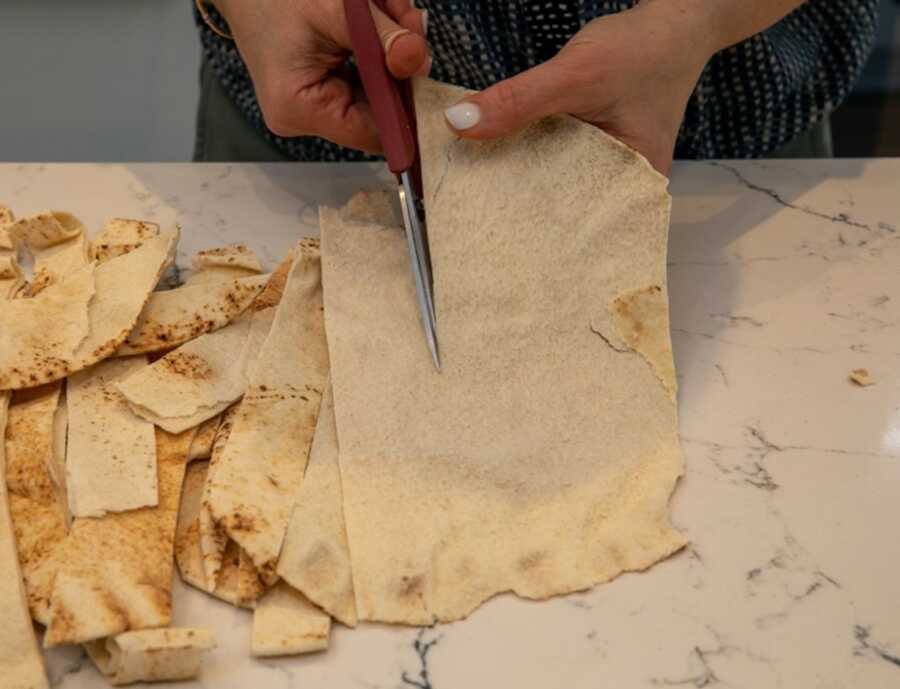
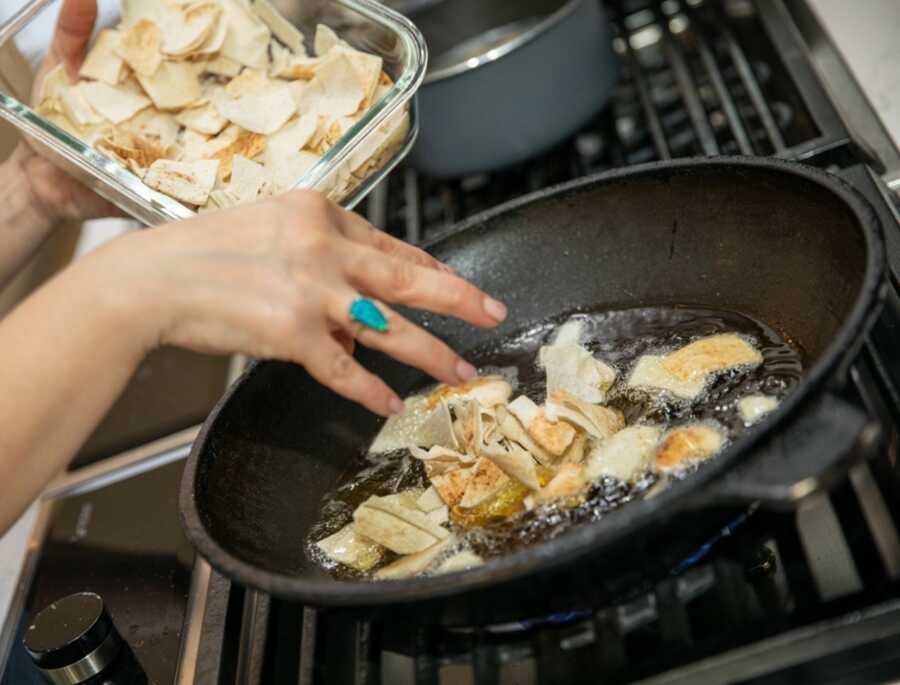
3. Remove and drain the fried bread on paper towels. Repeat. Place the bread in the serving dish.
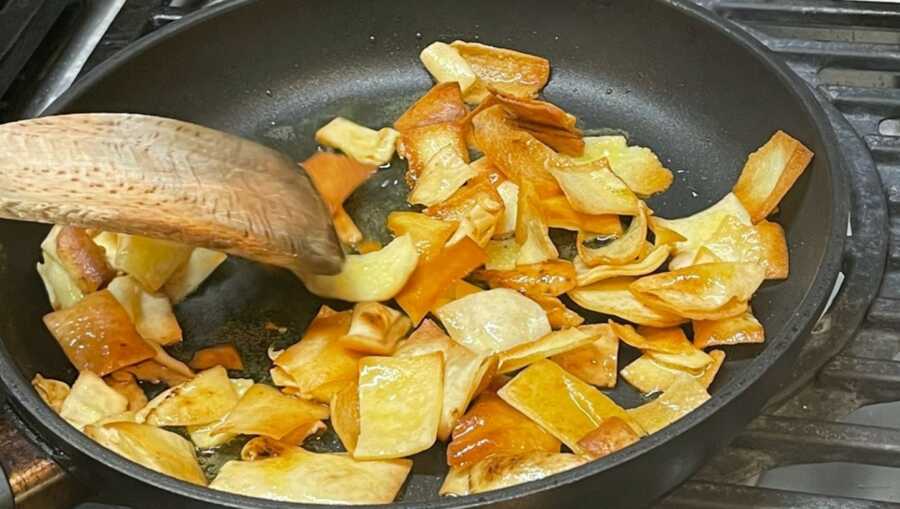
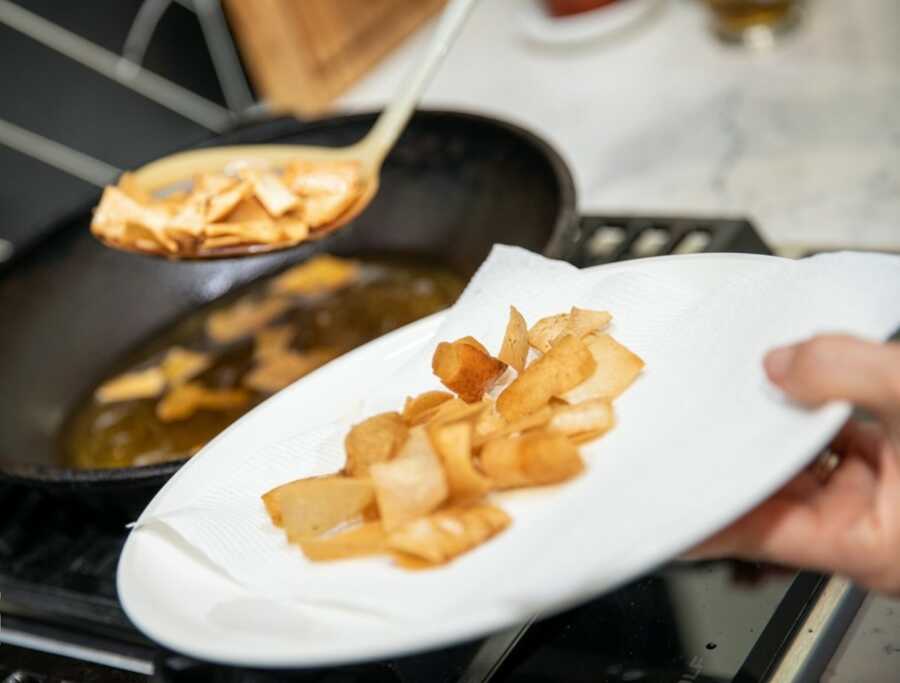
4. To make the yogurt sauce, add crushed garlic, natural yogurt, tahini, salt, and water into a bowl and mix until smooth.
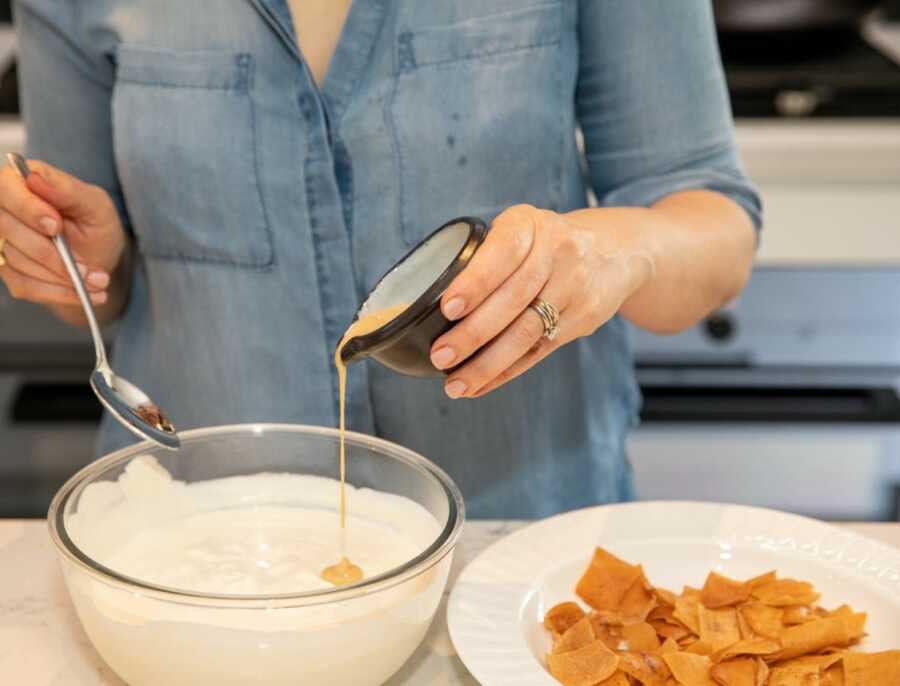
5. To serve individually, layer the crispy bread in a shallow bowl and add drained chickpeas (keep a handful of chickpeas for garnish).
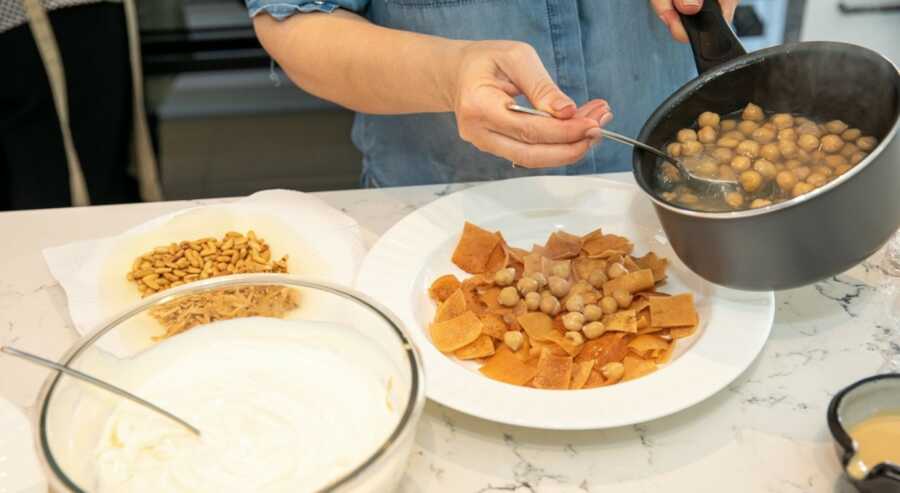
6. Next, pour the yogurt mixture over the top and finish off with the extra chickpeas.
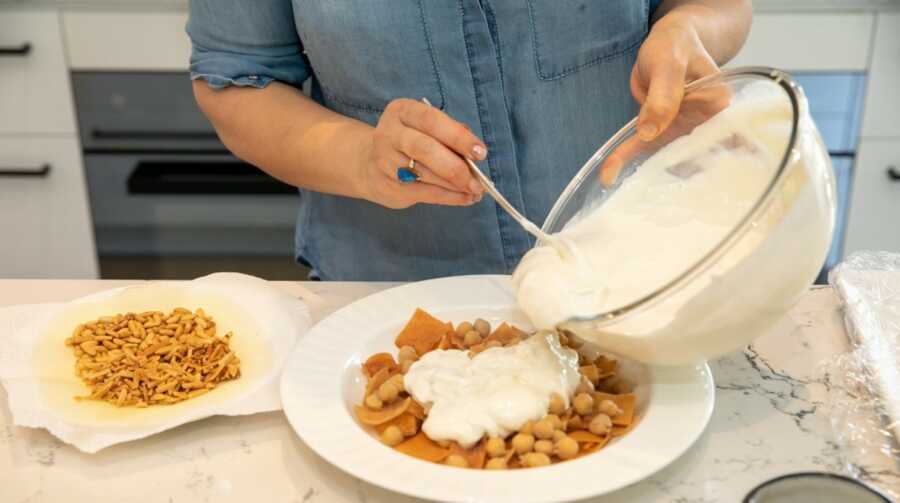
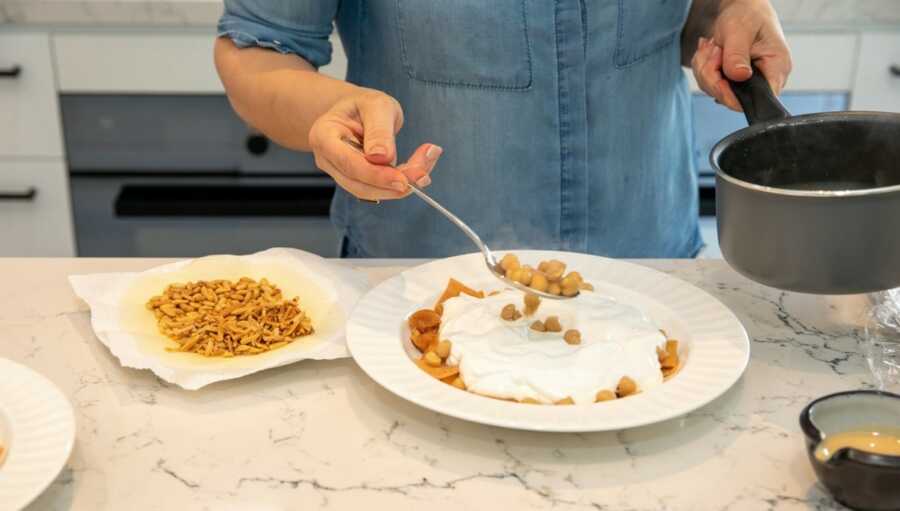
7. Heat the one extra tablespoon of ghee in a small frying pan, add the pine nuts. Stir until golden in color.
8. Drizzle the hot ghee and pine nuts over the yogurt (this will make a TOOSH SOUND — that’s the sound the hot ghee makes when it hits the cold yogurt).
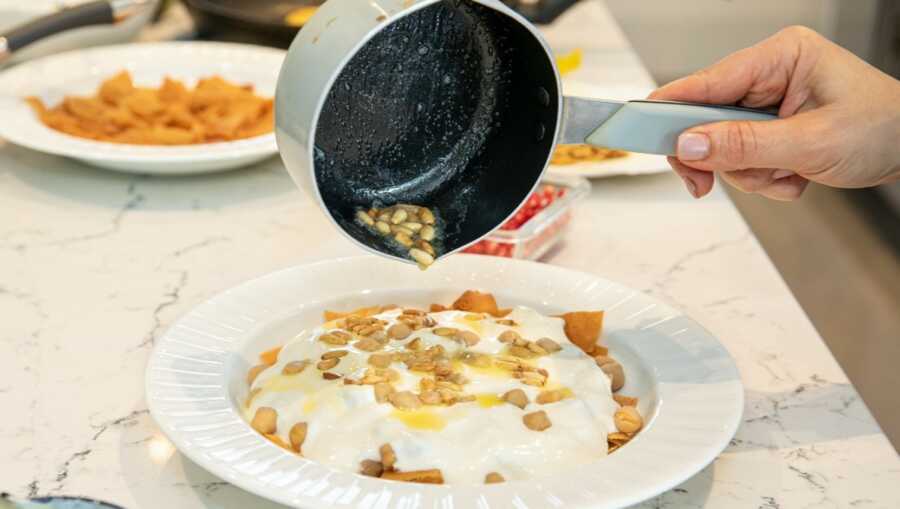
9. Garnish with chopped parsley and enjoy! Optional: You can also serve it with a sprinkle of paprika or pomegranate seeds.
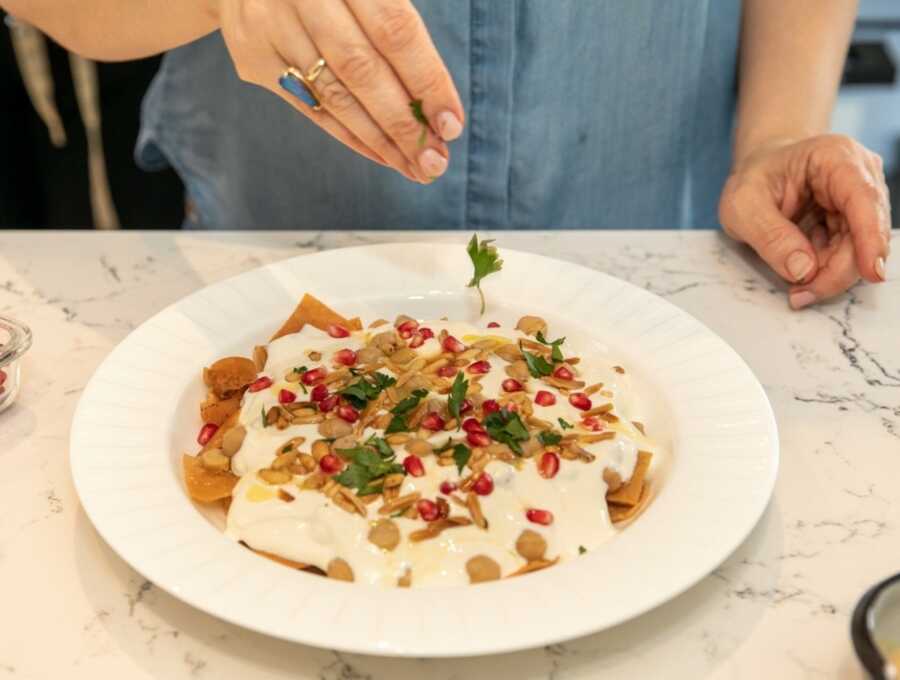

About This Recipe
Even before my food journey started, I was long aware that food, family, and culture are closely intertwined in the Middle Eastern world. But as my passion for cooking turned into sharing simple, traditional recipes with an online community of beautiful people hungry to learn more about our culture, I began to see the real magic of this link.
The marks that family memories, stories, and traditions leave on these recipes give them a unique flavor that goes beyond the ingredients I use. All the recipes I’ve grown up with bear these marks, more so the ones prepared for our large family gatherings during the holy month of Ramadan.
For Muslims all around the world, Ramadan is more than the act of fasting from sunrise to sunset. It’s a celebration of love, peace, and sharing that reminds us to be grateful for the blessings in our lives.
Of all the dishes one can find on the Ramadan table, whether it’s for suhoor (early morning breakfast before sunrise) or the iftar dinner, fatteh is by far my favorite. While it would be a lie to say the savory layers of crispy flatbread, chickpeas, and garlicky tahini and yogurt sauce have nothing to do with it, my childhood memories are the ones making me turn to this recipe over and over again.
I remember the joy I felt as a child in Lebanon while watching people come together onto the streets at night to break the fast and share delicious food with their neighbors. I have so many dear memories from that time that bring back a strong sense of community. They’re simple moments like hearing the sound of the drummer who walked around the village where I grew up before dawn to wake people up for suhoor.
The only thing that got me out of bed that early in the morning was the possibility that mom had made fatteh for my siblings and me. It was (and still is) the perfect food you can eat on an empty stomach. Plus, the addition of tahini in the yogurt sauce, which comes from my mom’s region in Lebanon, made it seem like the best dish in the whole world.
Garnished generously with whole toasted pine nuts, the secret of this dish lies in the way you layer each ingredient at just the right time. Assembling a plate of fatteh needs to be done right before serving it. Otherwise, the bread gets soggy, losing its tasty crunch. That’s why fatteh is the last iftar dish I make before sitting down to eat with my family.
Usually, the whole house is gathered around me in the kitchen as I assemble the fatteh. They’re all waiting for me to pour the ghee and pine nuts on top to hear the famous TOOSH sound. That’s the sound the hot ghee makes when it hits the cold yogurt sauce. Where I come from, if it doesn’t make that sound, your fatteh is considered a fail.
Our recipes have their flavor spiced up by bits of family lore and tradition. This unique blend makes it essential to treasure them and pass them on to the next generations. As such, I’m excited to be sharing my fatteh recipe with you and I hope you enjoy it as much as my family does.
As we say in Arabic, Sahtan – enjoy in good health.

Lebanese Chickpea Fatteh Recipe
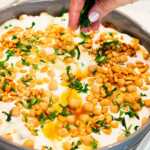
Arabic bread topped with chickpeas, yogurt, and pine nuts.
- Individual serving bowls or a glass/ceramic baking dish
- Small pot
- Medium-sized frying pan
- medium-sized bowl
- Spoons
- 28 ounces canned chickpeas
- 4 tbs ghee or oil ((for deep frying))
- 2 large rounds Arabic pocket bread ((cut into 2-3 cm squares))
- 2 cloves garlic ((crushed))
- 2 pounds natural Greek yogurt
- 3 tbs tahini ((hulled))
- 4-5 tbs cold water
- salt ((to season))
- 1 tbs ghee ((extra))
- 1/3 cup pine nuts
-
Rinse the chickpeas from canning liquid and add them to a pot with 2 cups of water. Boil for approximately 25 minutes or until softened.
-
In the meantime, cut and fry the bread in two batches. Heat ½ of the ghee in a frying pan over medium heat. Add ½ of the Arabic bread and fry until golden brown.
-
Remove and drain the fried bread on paper towels. Repeat. Place the bread in the serving dish.
-
To make the yogurt sauce, add crushed garlic, natural yogurt, tahini, salt, and water into a bowl and mix until smooth.
-
To serve individually, layer the crispy bread in a shallow bowl and add drained chickpeas (keep a handful of chickpeas for garnish).
-
Next, pour the yogurt mixture over the top and finish off with the extra chickpeas.
-
Heat the one extra tablespoon of ghee in a small frying pan, add the pine nuts. Stir until golden in color.
-
Drizzle the hot ghee and pine nuts over the yogurt (this will make a TOOSH SOUND — that’s the sound the hot ghee makes when it hits the cold yogurt).
-
Garnish with chopped parsley and enjoy! Optional: You can also serve it with a sprinkle of paprika or pomegranate seeds.
There are no rules when it comes to frying your bread — you can fry the bread with olive oil or butter instead of ghee if you prefer.
You can swap ghee for olive oil when frying the pine nuts.
This recipe feeds up to 8 people. To prepare a smaller portion, half the quantities and use a small serving dish.
Since the quality of tahini can vary depending on the brand, you might need to add more water.
You need to eat this dish straight away so you can get the best out of the crispy bread once it’s soaked with the garlicky tahini yogurt sauce.
This story was submitted to Love What Matters by Rouba Shahin. You can follow her incredible food journey on Instagram. Submit your own story here, and be sure to subscribe to our free email newsletter for our best stories, and YouTube for our best videos.
Explore more recipes:
Late Father’s Traditional Spanish Canelones
Mexican Dad’s Traditional Slow-Cooked Pork Carnitas
Grandma’s Traditional Mexican Red Chili Pork
Single Mom’s Crispy Ham And Cheese Melts On A Budget
Spread love and laughter through food. SHARE this story on Facebook with friends and family.

